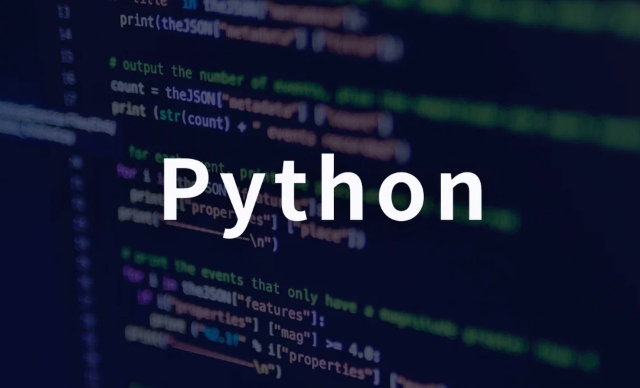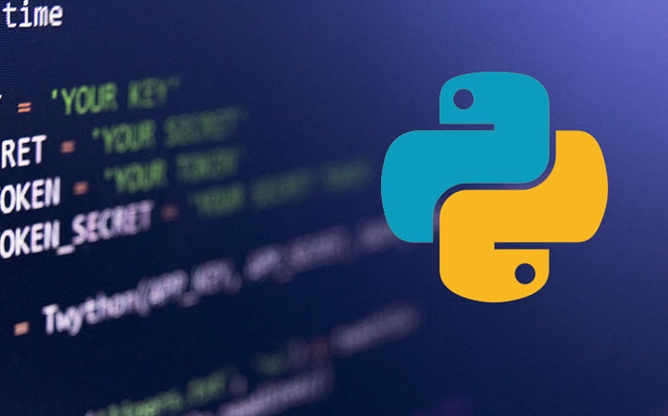To test the API, you need to use Python's Requests library. The steps are to install the library, send requests, verify responses, set timeouts and retry. First, install the library through pip install requests; then send GET or POST requests using requests.get() or requests.post(); then check response.status_code and response.json() to ensure that the return result is in compliance with expectations; finally, add timeout parameters to set the timeout time, and combine the retrying library to achieve automatic retry to enhance stability.

Testing APIs is an important part of developing and debugging web applications. Python is a powerful and syntactical language that is perfect for doing this. You can use it to quickly verify that the interface is working properly and that the response is in line with expectations.

Install the Requests library
To test the API, the most commonly used and most convenient library is requests . It encapsulates most of the HTTP request logic and is very intuitive to use.
If you haven't installed it, you can install it through pip:

pip install requests
After the installation is complete, you can import and start using it. For example, send a GET request to obtain data:
import requests response = requests.get('https://api.example.com/data') print(response.status_code) print(response.json())
Send different types of requests
Common operations of the RESTful API include GET, POST, PUT, and DELETE. Each type has different uses, such as GET for reading data and POST for creating resources.

- GET : Get information
- POST : Submit new data
- PUT : Update existing data
- DELETE : Delete data
Taking the POST request as an example, you may need to pass some parameters, usually in JSON format:
data = {'username': 'test', 'password': '123456'}
response = requests.post('https://api.example.com/login', json=data) Note that json=data parameter is used here, which will automatically set Content-Type to application/json and convert the dictionary into a JSON string.
Verify the response result
After calling the interface, the most important thing is to check whether the returned result meets expectations. Common judgment points include status code, response content, and response header.
- Status code 200 indicates that data is successfully obtained
- 404 means that the resource does not exist
- 401 Indicates that it is not authorized
- 500 indicates server error
You can add a simple judgment statement to assist in the test:
if response.status_code == 200:
print("Request successful")
else:
print(f"Request failed, status code: {response.status_code}")In addition, if the returned JSON data, it is recommended to print it out to see if the structure is correct:
print(response.json())
Set timeout and retry mechanism (optional)
In actual testing, network instability may cause request failure. To get closer to the real scene, you can add a timeout setting in the code:
response = requests.get('https://api.example.com/data', timeout=5)
In this example, a 5-second timeout time is set. If the response is not received after this time, an exception will be thrown.
If you want to make your program more "smart" when the network fluctuates, you can also combine retrying or tenacity libraries to achieve automatic retry.
Basically that's it. Testing APIs with Python is not complicated but it is easy to ignore details, such as parameter format, encoding method or error handling. Just master a few key points and you can get started quickly.
The above is the detailed content of How to test an API with Python. For more information, please follow other related articles on the PHP Chinese website!

Hot AI Tools

Undress AI Tool
Undress images for free

Undresser.AI Undress
AI-powered app for creating realistic nude photos

AI Clothes Remover
Online AI tool for removing clothes from photos.

Clothoff.io
AI clothes remover

Video Face Swap
Swap faces in any video effortlessly with our completely free AI face swap tool!

Hot Article

Hot Tools

Notepad++7.3.1
Easy-to-use and free code editor

SublimeText3 Chinese version
Chinese version, very easy to use

Zend Studio 13.0.1
Powerful PHP integrated development environment

Dreamweaver CS6
Visual web development tools

SublimeText3 Mac version
God-level code editing software (SublimeText3)

Hot Topics
 How to handle API authentication in Python
Jul 13, 2025 am 02:22 AM
How to handle API authentication in Python
Jul 13, 2025 am 02:22 AM
The key to dealing with API authentication is to understand and use the authentication method correctly. 1. APIKey is the simplest authentication method, usually placed in the request header or URL parameters; 2. BasicAuth uses username and password for Base64 encoding transmission, which is suitable for internal systems; 3. OAuth2 needs to obtain the token first through client_id and client_secret, and then bring the BearerToken in the request header; 4. In order to deal with the token expiration, the token management class can be encapsulated and automatically refreshed the token; in short, selecting the appropriate method according to the document and safely storing the key information is the key.
 How to test an API with Python
Jul 12, 2025 am 02:47 AM
How to test an API with Python
Jul 12, 2025 am 02:47 AM
To test the API, you need to use Python's Requests library. The steps are to install the library, send requests, verify responses, set timeouts and retry. First, install the library through pipinstallrequests; then use requests.get() or requests.post() and other methods to send GET or POST requests; then check response.status_code and response.json() to ensure that the return result is in compliance with expectations; finally, add timeout parameters to set the timeout time, and combine the retrying library to achieve automatic retry to enhance stability.
 Python variable scope in functions
Jul 12, 2025 am 02:49 AM
Python variable scope in functions
Jul 12, 2025 am 02:49 AM
In Python, variables defined inside a function are local variables and are only valid within the function; externally defined are global variables that can be read anywhere. 1. Local variables are destroyed as the function is executed; 2. The function can access global variables but cannot be modified directly, so the global keyword is required; 3. If you want to modify outer function variables in nested functions, you need to use the nonlocal keyword; 4. Variables with the same name do not affect each other in different scopes; 5. Global must be declared when modifying global variables, otherwise UnboundLocalError error will be raised. Understanding these rules helps avoid bugs and write more reliable functions.
 Python FastAPI tutorial
Jul 12, 2025 am 02:42 AM
Python FastAPI tutorial
Jul 12, 2025 am 02:42 AM
To create modern and efficient APIs using Python, FastAPI is recommended; it is based on standard Python type prompts and can automatically generate documents, with excellent performance. After installing FastAPI and ASGI server uvicorn, you can write interface code. By defining routes, writing processing functions, and returning data, APIs can be quickly built. FastAPI supports a variety of HTTP methods and provides automatically generated SwaggerUI and ReDoc documentation systems. URL parameters can be captured through path definition, while query parameters can be implemented by setting default values ??for function parameters. The rational use of Pydantic models can help improve development efficiency and accuracy.
 Python for loop with timeout
Jul 12, 2025 am 02:17 AM
Python for loop with timeout
Jul 12, 2025 am 02:17 AM
Add timeout control to Python's for loop. 1. You can record the start time with the time module, and judge whether it is timed out in each iteration and use break to jump out of the loop; 2. For polling class tasks, you can use the while loop to match time judgment, and add sleep to avoid CPU fullness; 3. Advanced methods can consider threading or signal to achieve more precise control, but the complexity is high, and it is not recommended for beginners to choose; summary key points: manual time judgment is the basic solution, while is more suitable for time-limited waiting class tasks, sleep is indispensable, and advanced methods are suitable for specific scenarios.
 Python for loop over a tuple
Jul 13, 2025 am 02:55 AM
Python for loop over a tuple
Jul 13, 2025 am 02:55 AM
In Python, the method of traversing tuples with for loops includes directly iterating over elements, getting indexes and elements at the same time, and processing nested tuples. 1. Use the for loop directly to access each element in sequence without managing the index; 2. Use enumerate() to get the index and value at the same time. The default index is 0, and the start parameter can also be specified; 3. Nested tuples can be unpacked in the loop, but it is necessary to ensure that the subtuple structure is consistent, otherwise an unpacking error will be raised; in addition, the tuple is immutable and the content cannot be modified in the loop. Unwanted values can be ignored by \_. It is recommended to check whether the tuple is empty before traversing to avoid errors.
 How to parse large JSON files in Python?
Jul 13, 2025 am 01:46 AM
How to parse large JSON files in Python?
Jul 13, 2025 am 01:46 AM
How to efficiently handle large JSON files in Python? 1. Use the ijson library to stream and avoid memory overflow through item-by-item parsing; 2. If it is in JSONLines format, you can read it line by line and process it with json.loads(); 3. Or split the large file into small pieces and then process it separately. These methods effectively solve the memory limitation problem and are suitable for different scenarios.
 Sending emails from Python script
Jul 12, 2025 am 12:18 AM
Sending emails from Python script
Jul 12, 2025 am 12:18 AM
TosendemailsusingPython,usethesmtplibandemaillibraries.1)SetupSMTPwithserverdetailsandlogincredentials.2)ComposetheemailusingEmailMessagetosetcontent,subject,sender,andrecipient.3)Sendthemessageviaserver.send_message()andclosetheconnectionwithserver.






